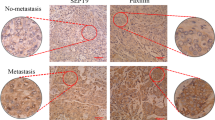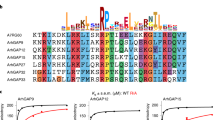Abstract
WAVEs (WASP-family verprolin-homologous proteins) regulate the actin cytoskeleton through activation of Arp2/3 complex. As cell motility is regulated by actin cytoskeleton rearrangement and is required for tumor invasion and metastasis, blocking actin polymerization may be an effective strategy to prevent tumor dissemination. We show that WAVEs, especially WAVE2, are essential for invasion and metastasis of melanoma cells. Malignant B16F10 mouse melanoma cells expressed more WAVE1 and WAVE2 proteins and showed higher Rac activity than B16 parental cells, which are neither invasive nor metastatic. The effect of WAVE2 silencing by RNA interference (RNAi) on the highly invasive nature of B16F10 cells was more dramatic than that of WAVE1 RNAi. Membrane ruffling, cell motility, invasion into the extracellular matrix, and pulmonary metastasis of B16F10 cells were suppressed by WAVE2 RNAi. WAVE2 RNAi also had a profound effect on invasion induced by a constitutively active form of Rac (RacCA). In addition, ectopic expression of both RacCA and WAVE2 in B16 cells resulted in further increase in the invasiveness than that observed in B16 cells expressing only RacCA. Thus, WAVE2 acts as the primary effector downstream of Rac to achieve invasion and metastasis, suggesting that suppression of WAVE2 activity holds a promise for preventing cancer invasion and metastasis.
This is a preview of subscription content, access via your institution
Access options
Subscribe to this journal
Receive 50 print issues and online access
$259.00 per year
only $5.18 per issue
Buy this article
- Purchase on Springer Link
- Instant access to full article PDF
Prices may be subject to local taxes which are calculated during checkout






Similar content being viewed by others
References
Aguirre-Ghiso JA, Estrada Y, Liu D and Ossowski L . (2003). Cancer Res., 63, 1684–1695.
Bartolome RA, Galvez BG, Longo N, Baleux F, Van Muijen GN, Sanchez-Mateos P, Arroyo AG and Teixido J . (2004). Cancer Res., 64, 2534–2543.
Brummelkamp TR, Bernards R and Agami R . (2002). Science, 296, 550–553.
Chrzanowska-Wodnicka M and Burridge K . (1996). J. Cell Biol., 133, 1403–1415.
Clark EA, Golub TR, Lander ES and Hynes RO . (2000). Nature, 406, 532–535.
Connolly JO, Simpson N, Hewlett L and Hall A . (2002). Mol. Biol. Cell, 13, 2474–2485.
De Corte V, Bruyneel E, Boucherie C, Mareel M, Vandekerckhove J and Gettemans J . (2002). EMBO J., 21, 6781–6790.
Fidler IJ . (1973). Nat. New Biol., 242, 148–149.
Friedl P and Wolf K . (2003). Nat. Rev. Cancer, 3, 362–374.
Giavazzi R and Garofalo A . (2001). Metastasis Research Protocols, Vol 2: Analysis of Cell Behavior In Vitro and In Vivo . Brooks SA and Schumacher U (eds). Humana Press: NJ, pp. 223–229.
Hanahan D and Weinberg RA . (2000). Cell, 100, 57–70.
Hsia DA, Mitra SK, Hauck CR, Streblow DN, Nelson JA, Ilic D, Huang S, Li E, Nemerow GR, Leng J, Spencer KS, Cheresh DA and Schlaepfer DD . (2003). J. Cell Biol., 160, 753–767.
Joyce PL and Cox AD . (2003). Cancer Res., 63, 7959–7967.
Kobayashi H, Ohi H, Sugimura M, Shinohara H, Fujii T and Terao T . (1992). Cancer Res., 52, 3610–3614.
Li Y, Tondravi M, Liu J, Smith E, Haudenschild CC, Kaczmarek M and Zhan X . (2001). Cancer Res., 61, 6906–6911.
Maekawa M, Ishizaki T, Boku S, Watanabe N, Fujita A, Iwamatsu A, Obinata T, Ohashi K, Mizuno K and Narumiya S . (1999). Science, 285, 895–898.
Menna PL, Skilton G, Leskow FC, Alonso DF, Gomez DE and Kazanietz MG . (2003). Cancer Res., 63, 2284–2291.
Michiels F, Habets GG, Stam JC, van der Kammen RA and Collard JG . (1995). Nature, 375, 338–340.
Miki H, Miura K and Takenawa T . (1996). EMBO J., 15, 5326–5335.
Miki H, Sasaki T, Takai Y and Takenawa T . (1998a). Nature, 391, 93–96.
Miki H, Suetsugu S and Takenawa T . (1998b). EMBO J., 17, 6932–6941.
Miki H, Yamaguchi H, Suetsugu S and Takenawa T . (2000). Nature, 408, 732–735.
Molnar A, Theodoras AM, Zon LI and Kyriakis JM . (1997). J. Biol. Chem., 272, 13229–13235.
Nozumi M, Nakagawa H, Miki H, Takenawa T and Miyamoto S . (2003). J. Cell Sci., 116, 239–246.
Ortega A, Ferrer P, Carretero J, Obrador E, Asensi M, Pellicer JA and Estrela JM . (2003). J. Biol. Chem., 278, 39591–39599.
Sahai E and Marshall CJ . (2002). Nat. Rev. Cancer, 2, 133–142.
Sahai E and Marshall CJ . (2003). Nat. Cell Biol., 5, 711–719.
Segall JE, Tyerech S, Boselli L, Masseling S, Helft J, Chan A, Jones J and Condeelis J . (1996). Clin. Exp. Metastasis, 14, 61–72.
Soderling SH, Langeberg LK, Soderling JA, Davee SM, Simerly R, Raber J and Scott JD . (2003). Proc. Natl. Acad. Sci. USA, 100, 1723–1728.
Suetsugu S, Miki H and Takenawa T . (1999). Biochem. Biophys. Res. Commun., 260, 296–302.
Suetsugu S, Miki H and Takenawa T . (2002a). Cell Motil. Cytoskeleton, 51, 113–122.
Suetsugu S, Hattori M, Miki H, Tezuka T, Yamamoto T, Mikoshiba K and Takenawa T . (2002b). Dev. Cell, 3, 645–658.
Suetsugu S, Yamazaki D, Kurisu S and Takenawa T . (2003). Dev. Cell, 5, 595–609.
Takaishi K, Sasaki T, Kotani H, Nishioka H and Takai Y . (1997). J. Cell Biol., 139, 1047–1059.
Takenaka K, Moriguchi T and Nishida E . (1998). Science, 280, 599–602.
Takenawa T and Miki H . (2001). J. Cell Sci., 114, 1801–1809.
Vial E, Sahai E and Marshall CJ . (2003). Cancer Cell, 4, 67–79.
Voura EB, Sandig M, Kalnins VI and Siu C . (1998). Cell Tissue Res., 293, 375–387.
Wolf K, Mazo I, Leung H, Engelke K, von Andrian UH, Deryugina EI, Strongin AY, Brocker EB and Friedl P . (2003). J. Cell Biol., 160, 267–277.
Yamaguchi H, Kitayama J, Takuwa N, Arikawa K, Inoki I, Takehara K, Nagawa H and Takuwa Y . (2003). Biochem. J., 374, 715–722.
Yamazaki D, Suetsugu S, Miki H, Kataoka Y, Nishikawa S, Fujiwara T, Yoshida N and Takenawa T . (2003). Nature, 424, 452–456.
Yan C, Martinez-Quiles N, Eden S, Shibata T, Takeshima F, Shinkura R, Fujiwara Y, Bronson R, Snapper SB, Kirschner MW, Geha R, Rosen FS and Alt FW . (2003). EMBO J., 22, 3602–3612.
Yoshioka K, Foletta V, Bernard O and Itoh K . (2003). Proc. Natl. Acad. Sci. USA, 100, 7247–7752.
Yu HR and Schultz RM . (1990). Cancer Res., 50, 7623–7633.
Zhuge Y and Xu J . (2001). J. Biol. Chem., 276, 16248–16256.
Zucker S, Cao J and Chen WT . (2000). Oncogene, 19, 6642–6650.
Acknowledgements
We thank members of the laboratory for help and advice throughout this study, Dr T Azuma for providing the anti-Rac1 antibody, and Dr H Nakagawa for GFP-tagged WAVE1 and WAVE2 constructs. The work was supported by grants-in-aid from the Ministry of Education, Culture, Sports, and Technology of Japan and from the Japan Science and Technology Corporation (JST).
Author information
Authors and Affiliations
Corresponding author
Additional information
Supplementary Information accompanies the paper on Oncogene website (http://www.nature.com/onc)
Rights and permissions
About this article
Cite this article
Kurisu, S., Suetsugu, S., Yamazaki, D. et al. Rac-WAVE2 signaling is involved in the invasive and metastatic phenotypes of murine melanoma cells. Oncogene 24, 1309–1319 (2005). https://doi.org/10.1038/sj.onc.1208177
Received:
Revised:
Accepted:
Published:
Issue Date:
DOI: https://doi.org/10.1038/sj.onc.1208177
Keywords
This article is cited by
-
Endocytosis in cancer and cancer therapy
Nature Reviews Cancer (2023)
-
LncIRF1 promotes chicken resistance to ALV-J infection
3 Biotech (2023)
-
Hypomethylation-mediated upregulation of the WASF2 promoter region correlates with poor clinical outcomes in hepatocellular carcinoma
Journal of Experimental & Clinical Cancer Research (2022)
-
Deficiency of Wiskott–Aldrich syndrome protein has opposing effect on the pro-oncogenic pathway activation in nonmalignant versus malignant lymphocytes
Oncogene (2021)
-
Phosphorylation of the proline-rich domain of WAVE3 drives its oncogenic activity in breast cancer
Scientific Reports (2021)



